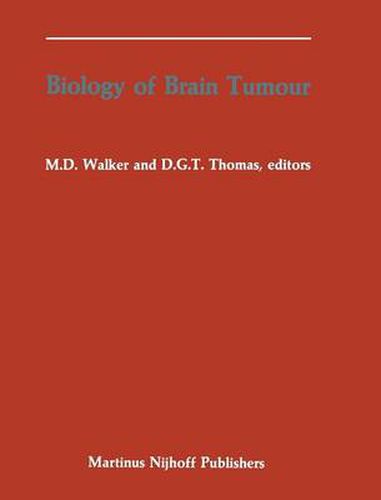Readings Newsletter
Become a Readings Member to make your shopping experience even easier.
Sign in or sign up for free!
You’re not far away from qualifying for FREE standard shipping within Australia
You’ve qualified for FREE standard shipping within Australia
The cart is loading…






This title is printed to order. This book may have been self-published. If so, we cannot guarantee the quality of the content. In the main most books will have gone through the editing process however some may not. We therefore suggest that you be aware of this before ordering this book. If in doubt check either the author or publisher’s details as we are unable to accept any returns unless they are faulty. Please contact us if you have any questions.
This volume contains the proceedings of the Second International Symposium on Biology of Brain Tumour. The first Symposium was held in 1979 at Gardonne Riviera, Italy. This meeting was planned in order to coincide with the lOOth Anniversary of the first reported operation for glioma in London on November 25, 1884. Since the first meeting, the field of neuro-oncology has made remarkable progress in understanding both basic and clinical factors of significance to patients with brain tumor. While the earlier meeting dealt to a large extent with clinically oriented studies, this symposium was more heavily weighted toward the biology of brain tumour and improving our understanding at the physiologic, biochemical, pharmacologic, and cellular level. The meeting was divided according to scientific content into presentations and discussions as well as posters for more leisurely viewing, so as to allow the main themes of the meeting to sequentially develop. The first session dealt extensively with neuro-oncology at the molecular level and included considerable discus sion of material related to the babic biochemical milieu in which tumors originate, proliferate, and eventually destroy the brain. Classic neuropathology has been the mainstay of tumor identification and characteriza tion, however, the process of classification has become much more complex. The availability of a variety of new tools has allowed investigation into the validity of the more traditional classification systems as well as the development of newer biologically related concepts.
$9.00 standard shipping within Australia
FREE standard shipping within Australia for orders over $100.00
Express & International shipping calculated at checkout
This title is printed to order. This book may have been self-published. If so, we cannot guarantee the quality of the content. In the main most books will have gone through the editing process however some may not. We therefore suggest that you be aware of this before ordering this book. If in doubt check either the author or publisher’s details as we are unable to accept any returns unless they are faulty. Please contact us if you have any questions.
This volume contains the proceedings of the Second International Symposium on Biology of Brain Tumour. The first Symposium was held in 1979 at Gardonne Riviera, Italy. This meeting was planned in order to coincide with the lOOth Anniversary of the first reported operation for glioma in London on November 25, 1884. Since the first meeting, the field of neuro-oncology has made remarkable progress in understanding both basic and clinical factors of significance to patients with brain tumor. While the earlier meeting dealt to a large extent with clinically oriented studies, this symposium was more heavily weighted toward the biology of brain tumour and improving our understanding at the physiologic, biochemical, pharmacologic, and cellular level. The meeting was divided according to scientific content into presentations and discussions as well as posters for more leisurely viewing, so as to allow the main themes of the meeting to sequentially develop. The first session dealt extensively with neuro-oncology at the molecular level and included considerable discus sion of material related to the babic biochemical milieu in which tumors originate, proliferate, and eventually destroy the brain. Classic neuropathology has been the mainstay of tumor identification and characteriza tion, however, the process of classification has become much more complex. The availability of a variety of new tools has allowed investigation into the validity of the more traditional classification systems as well as the development of newer biologically related concepts.